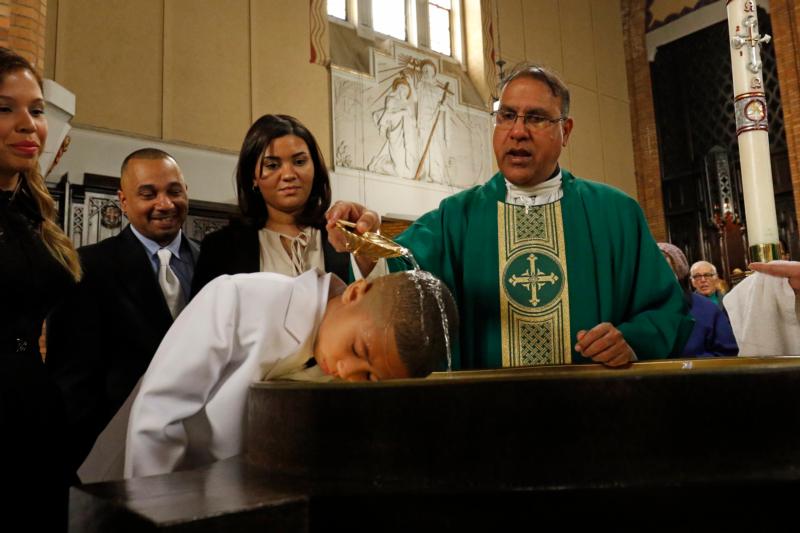
Jacob Rivera, 6, is baptized by Father Ilyas Gill during a Feb. 7, 2016, Mass at Immaculate Heart of Mary Church in Brooklyn, N.Y. Jesus said, “Let the children,” including infants, “come to me,” but he calls us all, whatever our age at baptism, to live a life of faith. (CNS photo/Gregory A. Shemitz)
The Catholic practice of baptizing infants is an “immemorial tradition of the church” according to the Catechism of the Catholic Church (No.1252).
Documents exist from as early as the second century that explain the practice, calling infants “children of God,” a phrase used only for those who had been baptized, and explicitly mentioning the baptism of infants, the 1980 “Instruction on Infant Baptism” states. Infant baptism was particularly strong in Africa, the instruction also notes.
While the Bible does not explicitly mention infant baptism, the practice quite likely developed in the earliest days of the church. As the catechism puts it, “it is quite possible that, from the beginning of the apostolic preaching, when whole ‘households’ received baptism, infants may also have been baptized” (No. 1252).
[hotblock]
There are several passages in the Bible that mention the baptism of “households.” The first appears in Acts 16, which records the story of St. Paul’s visit to Philippi in Macedonia. There he met Lydia, “a worshiper of God,” who was so moved by Paul’s message of salvation in Jesus that she and her whole household were baptized (Acts 16:12-15).
A similar story occurs in Act 16:25-34. Paul and Silas are in prison for preaching the Gospel when they are set free by an earthquake. Their jailer, seeing the earthquake as an omen from God asks, “Sirs, what must I do to be saved?”
He is told, “Believe in the Lord Jesus and you and your household will be saved.” Acts reports that “he and all his family were baptized at once.”
Other passages that refer to the baptism of entire households include Acts 18:8 and 1 Cor 1:16, where Paul acknowledges that he had “baptized the household of Stephanas.”
While none of these passages explicitly mentions the baptism of infants, infants are not explicitly omitted either. The use of the word “household” suggests that everyone that lived as a part of that family would have been baptized — including children and other relatives, family servants or even slaves. Why would any infants or young children in the family not be included?
The Catholic Church’s understanding of the sacrament of baptism — not just the practice of infant baptism — has been shaped by these particular Bible passages. Baptism, the catechism says, is a celebration of new birth in Christ Jesus that frees us from “the power of darkness” and brings us “into the realm of the freedom of the children of God.”
In baptism we experience the “shear gratuitousness of the grace of salvation,” not because of anything we do or say but simply through the freely given gift of God’s saving love for us (No. 1250). Isn’t the baptism of whole households, including infants, a perfect example of this?
Jesus said, “Let the children,” including infants, “come to me” (Lk 18:16), but he calls us all, whatever our age at baptism, to live a life of faith. Baptism marks the beginning of that life of faith, not the end.
***
Mulhall is a catechist living in Louisville, Kentucky.
PREVIOUS: Pastors who lead double lives wound the church, pope says
NEXT: Celebrating baptismal days each year affirms life of faith



Share this story